Rocket systems of the Hermes family
According to various sources, the development of the Hermes project could start in the first half of the nineties. The creation of the new complex was carried out by the Tula Instrument Design Bureau under the direction of A.G. Shipunova. By the end of the decade, all major design work had been completed, which allowed us to proceed with the creation of several modifications of the system, one of which was subsequently tested. So, in 2003, KBP and aviation industry successfully tested the aviation version of the Hermes complex (Hermes-A) on a Ka-52 type attack helicopter. Later, some additional work was carried out, according to the results of which the possibility of adopting a new system into service is considered.
At the heart of the Hermes project were several ideas designed to increase the efficiency of the finished weapons. To reduce the likelihood of the enemy’s retaliatory strike, it was necessary to bring the missile launch range to the maximum possible values. With the same purpose it was supposed to implement the principle of "shot and forget." As an additional means of control, it was proposed to use a laser guidance system. It was also proposed to equip the rocket with a relatively heavy high-explosive fragmentation warhead capable of destroying various targets: equipment, ground structures, ships, etc. To increase the effectiveness of the system in real combat, it was necessary to ensure the maximum speed of the missile’s flight, provide for the possibility of salvo firing, as well as ensure the transportation of the maximum possible ammunition load.
The study of the requirements led to the formation of the original appearance of a promising multipurpose missile system. It was assumed that the main element of the Hermes system would be a guided missile with the required characteristics. At the same time, the possibility of creating several modifications of the rocket with the maximum degree of unification and different characteristics was considered. Such missiles, as expected, can be used as part of all versions of the complex, regardless of the type of the base platform.
By installing the equipment of the complex for various types of equipment, it was possible to ensure the solution of combat missions in various conditions, as well as reduce the costs of creating, producing and operating systems of several models. The promotional materials for the project "Hermes" featured three main versions of the complex. The Hermes-S system was supposed to be based on a self-propelled automobile chassis and solve the tasks of defense against a ground or surface enemy. For work on the sea proposed the project "Hermes-K". In this case, the missile launcher was to be mounted on boats or ships. An option for the air force, intended for use on airplanes or helicopters, received the designation "Hermes-A". In some sources, this system is also referred to as “Peck” or “Peck-A”.
According to published data, the main element of the self-propelled ground complex "Hermes-S" was to be a fighting vehicle on a car chassis. It was proposed to mount two packages with 12 missile transport and launch containers on each one, as well as a missile radar station. Also in the promotional materials appeared launcher without means of guidance with a different layout of the block of missiles. Also, an additional vehicle with a search and control radar on an overhead mast device could be part of the land complex.
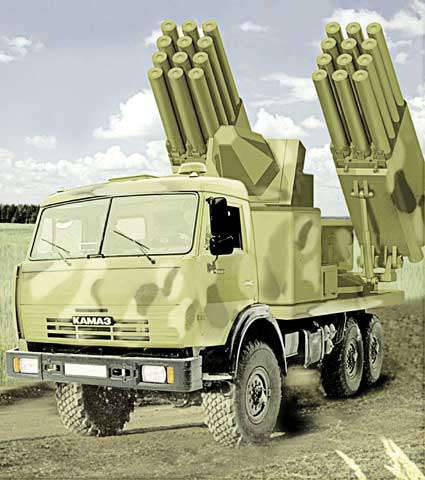
Combat vehicle complex "Hermes-S". Figure Rbase.new-factoria.ru
The sea complex "Hermes-K" was proposed for equipping small ships and boats in order to increase their firepower. It was supposed to make two versions of launchers. The first was a thumbnail unit with a turntable for targeting several TPCs with rockets. The second one had a simpler design and in fact was a set of brackets for attaching containers of missiles on the towers of shipboard artillery.
For various reasons, the Hermes-S and Hermes-K missile systems currently exist only in the form of drawings and images in promotional materials. As far as is known, the assembly of such systems was not carried out, and tests were not performed. The aviation system, in turn, has already passed several stages of testing and can be put into service in the foreseeable future.
According to reports, the Hermes-A aviation missile system consists of several main components: an optical-electronic system, a fire control system, and weapons. The composition of the optical-electronic system includes television and thermal imaging equipment, as well as a laser rangefinder on a stabilized platform, automatic target tracking and other nodes. The MSA includes a computing control system, a control panel, an automation unit, an information exchange line, etc. The armament of the complex consists of launchers, suspended under the wing of the base helicopter, and guided missiles.
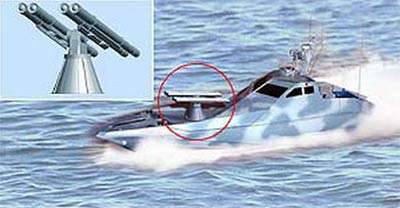
Boat with tumbova launcher complex "Hermes-K". Figure Militaryrussia.ru
The complex of the Hermes family includes several types of guided missiles that have the most unified design. All of them are built on a bicalyber scheme with a detachable first stage in the form of a high-energy solid-fuel engine. The second stage, in turn, bears the control equipment and the warhead. Flight control is carried out using a set of planes. At the tail end of the starting engine there is a set of X-shaped stabilizers, and at the second stage stabilizers (in the tail) and steering wheels (in the head section) of similar design are mounted. For release from TPK at the start, an additional propellant charge is applied.
According to some sources, missiles of the Hermes family can receive three types of homing heads: semi-active laser, infrared and active radar. Such systems provide the correct guidance to the specified goal, however, differ in terms of certain characteristics. For example, a laser seeker requires illumination of a target before it hits, while others implement the “launched-forgotten” principle. In addition, there are some restrictions on the simultaneous use of missiles. Thus, with the use of laser illumination, only two missiles can be launched simultaneously. Infrared and radar systems, in turn, allow you to simultaneously launch up to 12 missiles - almost the entire maximum ammunition helicopter.
Missiles of the Hermes complex, both aviation and other modifications, are proposed to be delivered in transport-launch containers unified with the Whirlwind complex. The total length of such a WPC with a missile is 3,5 m, weight - up to 110 kg with a launch weight of 90 kg. The launch stage of the rocket has a diameter of 170 mm, marching - 130 mm. The length of the second stage - 1,5 m, wing span - 240 mm. Aircraft missiles are proposed to be equipped with a high-explosive fragmentation warhead with a mass of 27,5 kg, of which about 12 kg is accounted for explosives.
One of the main tasks of the Hermes-A aviation missile system project was to increase the launch range to values that ensure the safe use of weapons without entering the enemy's air defense zone. In order to fulfill this requirement and reduce the mass of the rocket, the authors of the project went for some reduction in the flight parameters of the rocket compared to the maximum possible. The first launch stage at launch should accelerate the rocket to a speed of about 1000 m / s, which allows you to attack targets at distances up to 20 km. At the same time, the maximum launch range and effective attack depends on the type of target. So, at a distance of 20 km, you can effectively attack surface targets. When working on ground targets, the maximum range is 17 km, and on air - up to 15 km.
It was mentioned earlier that in the composition of the land and ship complexes Hermes-S and Hermes-K two types of guided missiles can be used, the main difference of which is the design of the first stage and, as a result, the flight range. A missile modification, unified with an aviation one, is capable of hitting targets at distances of no more than 20 km. Also mentioned was a rocket with a launch mass at the level of 130 km and a more powerful starting engine capable of reaching speeds of up to 1300 m / s and flying to a distance of up to 100 km.
The general public learned about the Hermes project at the beginning of the two thousandth. In addition, at this time the tests of the aviation version of the missile complex were launched. To carry out these works, which ended in the middle of 2003, special equipment was received by the Ka-52 helicopter. The completion of the tests allowed the industry not only to present new data, but also to include the attack helicopter with new weapons in the exposition at various exhibitions. The first demonstration of the experienced Ka-52 with the Hermes-A system was held at the MAKS exhibition in 2007. The shown helicopter was equipped with a platform with an optical-electronic system under the nose fairing, as well as launchers on pylons.
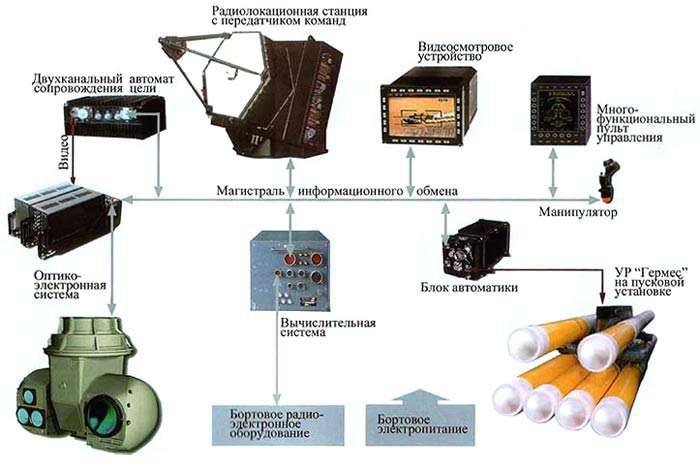
The architecture of the complex "Hermes-A". Figure Militaryrussia.ru
At the end of the last decade, it was reported that the Hermes-A complex had passed most of the tests and was ready to launch mass production. At the MAKS-2009 air show, a representative of the Tula Instrument Design Bureau stated that in the 2010, the aviation version of the missile complex must undergo flight tests, which will allow it to be put into service. Serial production commissioned by the Russian military could begin in 2011 or 2012 year.
For unnamed reasons, such plans were not implemented. Nevertheless, the work was not stopped and continued, the result of which should be the adoption of a new complex into service, even if a few years after the originally named date. So, in the fall of 2014, KBP representatives spoke about the continuation of joint work with Kamov and Mily firms, which should result in equipping domestic helicopters with the latest high-performance weapons. In addition, at that time, mention was made of the creation of long-range anti-tank missiles for arming the ground forces and the design of a similar system for fleet.
The last time question was raised about a year ago. In February, 2015, it was reported that KBP and Russian Helicopters are continuing to integrate the Hermes-A system into the armament complex of combat helicopters. In addition, by that time, the design and ground testing of the introduction of new missiles into the Su-25 attack complex had been completed. With the successful completion of all current work, mass production of new weapons can begin in the 2018 year. Then new missiles must go to the troops.
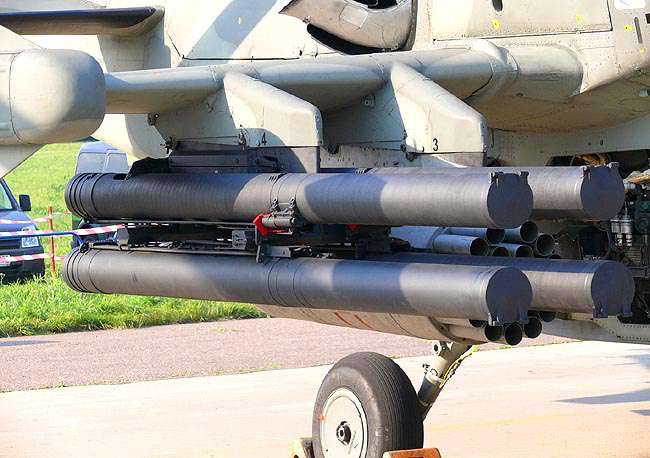
Launcher of the Hermes missiles under the wing of the Ka-52 helicopter. Photos Otvaga2004.ru
To date, determined the fate of only the aviation missile complex. Over the next few years, the industry should complete all the necessary work, which will allow it to begin rearming strike aircraft, expanding its combat capabilities. Prospects for the self-propelled complex "Hermes-S" and the sea "Hermes-K" are probably not determined yet. These systems may be of great interest to the armed forces, but projects have not yet been brought at least to the stage of full-fledged testing.
As already mentioned, the main goals of creating a promising Hermes-A aviation missile system were to increase the launch range and ensure the independent operation of missile automation without the participation of the operator or the helicopter’s on-board equipment. Judging by the available data, both tasks were successfully solved. However, the Hermes-A complex still has not reached the troops. At present, the industry is working on the refinement of this system and is preparing it for adoption. In addition, work is underway to expand the list of potential carriers of new missiles.
At the early testing stage, the carrier of the Hermes-A complex was a Ka-52 helicopter, which was further demonstrated at exhibitions. Open reports of recent years suggest that in the future this complex will be installed on Mi-brand helicopters. In addition, the integration of new missiles into the Su-25 aircraft weapons complex was mentioned.
The ongoing work will allow the Russian Air Force strike aircraft to be equipped with modern guided missiles with high performance and good potential. First of all, the capabilities of airplanes and helicopters will grow to strike without the need to enter the enemy’s air defense zone, and there will be no need for long-term rocket tracking and control before hitting the target. Unfortunately, to date, there has been some lag of domestic developments in this area from foreign counterparts. Nevertheless, the Hermes-A complex in the foreseeable future will make it possible to bridge this gap and increase the strike potential of domestic aviation.
On the materials of the sites:
http://kbptula.ru/
http://rbase.new-factoria.ru/
http://bastion-karpenko.ru/
http://otvaga2004.ru/
http://btvt.narod.ru/
http://militaryrussia.ru/blog/topic-49.html

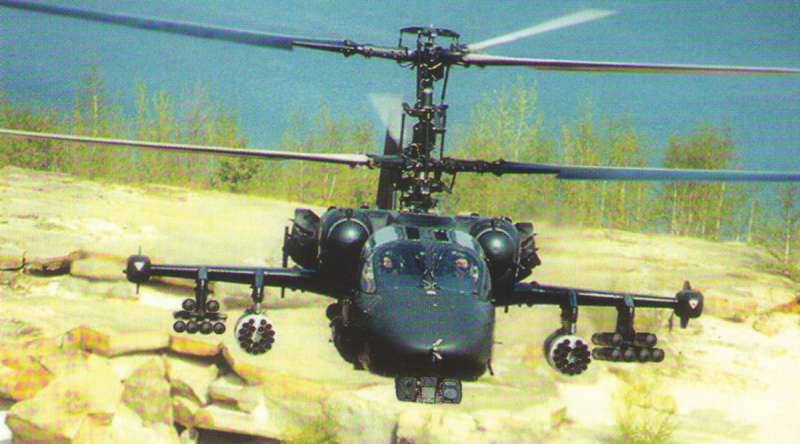
Information